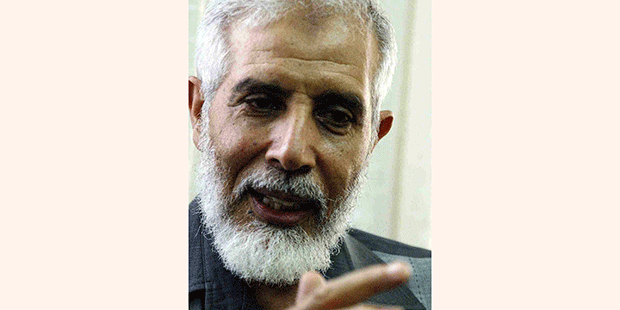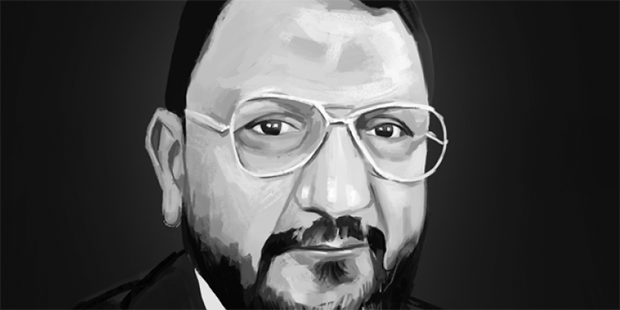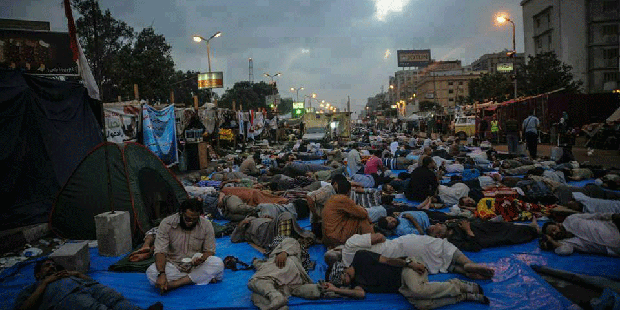Since it was driven underground after the coup of the summer of 2013 and the massacres that followed soon after, what has happened to the Muslim Brotherhood of Egypt? The vast and powerful century-old organization, survivor of so many cycles of repression and rejuvenation, is disintegrating.
It has become increasingly clear that the Muslim Brothers in Egypt are nearing a profound and lasting split, between a faction representing the traditional leadership, consensus based, top-down, oriented toward compromise with Egypt’s rulers, and a faction representing the younger activist base, seeking a more democratic organization of the Brothers, but also leaning toward violent confrontation with the regime. This article, written by Noon Post’s Ahmed Al-Tellawi in February of this year, carefully traced the origins of the split.
[…]
The conflict began around August, 2014, a year after the July 2013 coup and the events of Rabaa and al-Nahda square [in which government troops and police massacred around a thousand anti-coup protestors].
Sources in the Brotherhood’s underground Egypt organization told the Noon Post that the strife first erupted into an open dispute in Dec. 2014. At that point it became clear that there were significant differences of opinion regarding the tools and methods being used to manage the organization. A portion of the Muslim Brothers were criticizing the organization’s leadership (which had not yet fractured) for the way it was responding to the dire situation the Brotherhood found itself in.
In response, a ‘crisis unit’ was formed, composed of six Muslim Brothers, three of them from the Guidance Bureau [the highest body, composed of a dozen important figures]and three others who were leaders from the Shura Council [a larger elected body].
Mohammed Abderrahman was asked to join the Crisis Unit by the Brotherhood’s acting General Guide, Mahmoud Ezzat (who had taken over when the Brotherhood’s General Guide Mohammed Badie was arrested). By May of 2015, Abderrahman came to the conclusion that the Crisis Unit itself had become dysfunctional.
This was a period, it should be noted, when the leadership had chosen to radically downsize the organization, eliminating many of the Muslim Brotherhood’s most important bodies, among them the Muslim Sisters corps, the Charity section, and the Da’awa (proselytizing) section, while folding all of the group’s numerous educational programs into a single remaining institution.
The aim of these cuts seems to have been to impose unity on an organization that was already fissuring [as it went underground]following the coup and the Rabaa massacre; the younger base of the organization was starting to diverge from the older leadership.
Many circles of younger Muslim Brothers, both inside Egypt and abroad, held the leadership responsible for the 2013 bloodbath because of mistakes that had been made during Egypt’s transition period after the 2011 revolution, or other errors made after the July, 2013 military coup that toppled the Brothers from power.
According to several insiders, a clique within the 6-man “Crisis Unit” led by Hussein Ibrahim and Mohammed Kamal began making decisions about the Muslim Brotherhood organization without discussing them with the whole crisis unit. It was this behavior which the General Guide’s man in the group, Mohammed Abderrahman complained to his leader about.
Following the coup, the leadership of the Muslim Brothers had come up with a theoretical, multiphase plan for its underground existence in Egypt, with a final goal of overthrowing the military regime and restoring the rule of ‘legitimacy.’ First, the Brothers would ‘spread confusion,’ then they would ‘exhaust’ the regime, and in a final ‘decisive phase,’ a special section of the organization, the ‘strong arm project’ would carry out a number of very effective and specific operations against the regime. Financing and recruiting for the “strong arm project”, whose activities were not approved by the leadership of the Brothers in accordance with the binding charter of the Shura Council, became a primary focus of the conflict at the top of the organization.
Important Brotherhood leaders, among them General Guide Mahmoud Ezzat and his representative on the Crisis Unit Mohammed Abderrahman, as well as the Brotherhood’s secretary general, Mahmud Hussein, and the head of the education unit, Mohammed Wahdan, concurred that the time was not yet ripe for the third and final phase of the Brotherhood’s plan.

Mahmoud Ezzat, acting General Guide of the Muslim Brothers.
But the Ezzat faction believed that the clique led by Mohammed Kamal and Hussein Ibrahim had already started recruiting young Muslim Brothers to carry out special operations, such as attacking military and police checkpoints and barracks. The Ezzat/Abderrahman faction of the leadership opposed these operations, at least in the present, and in particular since in practice civilians were being killed along with members of the military and police forces.
The complaints about the special operations reverberated in the more radical wings of the Brotherhood; the reaction of Mohamed Kamal, Hussein Ibrahim and their followers was however to cloak their activities in even more secrecy, more convinced than ever that armed operations were needed.
On the other side of the divide, Mahmoud Ezzat and Mohammed Abderrahman began promoting new faces, from the organization’s smaller administrative sections, placing them in command of the regional branches of the Brotherhood.
These decisions were made without carrying out internal elections; the promotions being made directly by the Brotherhood’s leaders. Some of those promoted represented the radical current, a decision meant to appease the youth of the organization, who generally wanted the Brothers to take a more decisive posture, which is to say a more violent posture, toward the regime.
As a gesture of goodwill, the leadership formed a new Crisis Unit, appointing three members from the opposition faction of the Guidance Bureau, including Mohammed Kamal and Hussein Ibrahim. The new team was given a time frame of six months to propose responses to a very wide range of issues facing the Brothers. How should the group help the hundreds of Brothers who were facing death sentences? How could the rather abstract three-phase plan for confronting the regime be concretely implemented? And most broadly, given the new political reality, what should be the future direction of the Muslim Brotherhood organization?
Leaders of the Brotherhood’s organization in Egypt say the new team worked for four months without coming up with any results. All the while, and over the objections of Ezzat and Abderrahman, the radical faction of the unit continued preparing the organization for carrying out more acts of violence, as well as taking money from the fund that was set up to support the families of detainees and members who had been martyred and spending it on special actions. Eventually the fund was shut down so the money could be sent to the families through other means.
Others say the support money simply stopped altogether. Political analyst Ali Biksawi, as well as Assem Shalabi, president of the League of Arab Editors and for many years an important member of the Brotherhood’s central media committee and political section, both wrote on their Facebook pages that the flow of money to the families was stopped altogether, most clearly to the families of detainees who refused to follow the instructions of the leadership to close ranks and enter a dormant phase.
The sense of split worsened considerably when the head of the education unit, Wahdan was arrested amid rumors that the police had been tipped off by members of the so-called radical faction. An atmosphere of suspicion was beginning to spread within the organization.
Some sources in the organization say the internal conflict was actually aired in public by Mohammed Montasser-who is, depending on which faction you ask, either the current spokesman or the former spokesman of the Muslim Brothers. They say it was he who started leaking information about meetings in the Turkish Capital, Ankara, of foreign-based members of the Guidance Bureau and the Shura Council to the website Masr al Arabiya in early 2015.
The Montasser leaks precipitated several decisions by the traditional leadership which further contributed to the centrifugal forces in the organization, among them cuts to spending, and the formation of an investigative committee – members of which were appointed by Ezzat and Abderrahman. Particularly galling to some was the fact that these decisions were made by a body that many do not consider as representing the organization at all—the Brotherhood’s administrative bureau in London.
Among the decisions that the administrative bureau made was the suspension of Mohammed Kamal from the Guidance Bureau; Mohammed Monstasser was removed as official spokesman, and replaced by Talaat Fahmi. Abdallah Ezzat was dismissed from his post at the head of the Students Section after he published a series of articles last year here at Noon Post and on Khalij Online, accusing the old guard of the Brothers of undervaluing the lives of the organization’s members, and of cor`ruption and mismanagement.
The dismissals triggered an immediate response from the self-proclaimed “Higher Administrative Committee of the Muslim Brothers” [apparently the leadership of the underground organization in Egypt], announcing that it was the real representative of the organization, and that it had never issued any order suspending Mohammed Montasser as spokesman, and he therefore remained the official media contact for the organization.
As we peruse this chronology of the Brothers’ ongoing crisis, it is worth stepping back for a moment to consider how the fracture began to have an impact on pro-revolutionary protests in Egypt. According to several interviews I conducted, the suspensions and dismissals led to a deepening of the divide inside the [underground]organization in Egypt, to the point that local branches of the Muslim Brothers in the district of Qalubiyya, Alexandria, and Greater Cairo as well as others announced their support for the faction represented by spokesman Mohammed Montasser.
As the fracture worsened, the organization ended up with two separate Alexandria branches, one which followed the ‘legitimate’ leadership of Mahmoud Ezzat and Mahmoud Hussein, while the second was loyal to the radical faction represented publicly by Mohammed Montasser.
The Brothers who run the organization’s official website, “Ikhwan Online” started refusing to publish posts by the old leadership, who in turn appointed a new team of three members to represent the organization online, and launch a new website called “Ikhwan Site.”
The official website and the group’s spokesman are among the most important tools of dissemination [in the post-coup environment], so the competing chains of command created enormous confusion among lower echelon Muslim Brothers. In one ear they heard orders to get out on the street; in the other, to go dormant. One faction’s interests required they go out and protest, while the other found it convenient they be silent.
The crisis enveloped the most active elements of the Brotherhood: the students section and the media section, by far the most influential bodies for the majority of the group’s members, as well as being the most positive elements in the group’s relationship to society at large. They were also the bodies making the strongest demands that the organization assert a more violent and radical posture in the face of the regime.
At the same time, the situation pushed some younger Muslim Brothers – in Alexandria and Giza- to hive off and form their own third body which follows neither of the two main factions in the internal conflict, shying away from political involvement and restricting itself to merely debating theology in religious circles.
The situation of the Brothers became starkly apparent this year during the anniversary of the Jan. 25 revolution, marked by the complete absence of the public initiatives usually organized by the Brotherhood youth. And in contrast to last year, schools and universities resumed this year with no major events, neither protests nor public commemorations of the fourth anniversary of the revolution.
All of this is an indication of how the conflict between the two leading factions of the Brotherhood has had a tremendous impact on the revolutionary movement, and the continuation of protest in Egypt. An impact that will continue given the visible intransigence of both factions. The traditional leadership has refused numerous offers of mediation, including from [Doha-based Egyptian Islamist scholar] Yusuf al-Qaradawi. Many local Muslim Brothers worry that the important decisions are being made outside the organization, imposed on them in Egypt by the [Sissi] regime itself, or in Turkey to serve the interests of the Turkey’s rulers, rather than what the situation in Egypt requires. Neither faction, they feel, is anymore the master of its own decisions, and the crisis itself may be insoluble.
Both sides bear equal responsibility for the crisis. The radical confrontation faction of the Brothers seems not to take into account the present circumstances in Egypt, in which it would be very difficult for the organization and its supporters to enter into a new full confrontation with the regime, particularly since at this point such a clash would have large repercussions on the rest of society. The evidence is clear given what happened at Rabaa and Nahda squares: at a moment when the Brothers had a much stronger support coalition both inside and outside the country, they could not face down the regime in a violent confrontation. So how could things possibly turn out better in the present situation, with a weakened organization, and an Egyptian Public rendered indifferent to the idea of the revolution?

Mohammed Kamal, member of the Guidance Bureau.
On top of that, this faction’s strategy aligns almost perfectly with the regime’s present aims: the regime seeks to present the Muslim Brothers as terrorists, in a moment when there is none of the public support for violent confrontation with the state that was so clear on the “Day of Wrath” on January 28 2011 that kicked off the revolution. On that day, the violence directed at the police and the headquarters of the ruling party had the kind of popular support that gave it the legitimacy of a revolutionary action.
As for the other faction, those who want the organization to go into a long period of dormancy so that it might absorb the shock of all that has happened since the coup: they are simply not taking into account the black smoke that chokes the lungs of the organization’s own members, the murder of thousands, the arrest and detention of tens of thousands, the vast displacements of their Brothers and sisters and parents, neighbors and relatives. The leadership had a positive duty to show more decisiveness in its decision-making, or at the very least to work harder to absorb all of the anger.
To the contrary, they ignored too many calls to ramp up the protests inside of Egypt, calls from people of all stripes who opposed the military coup, not only among the Muslim Brothers.
Note: This translated version is a slightly condensed version of the Arabic original.
Ahmed Al Tellawi Translated from Arabic by International Boulevard
22 Oct 2016




































